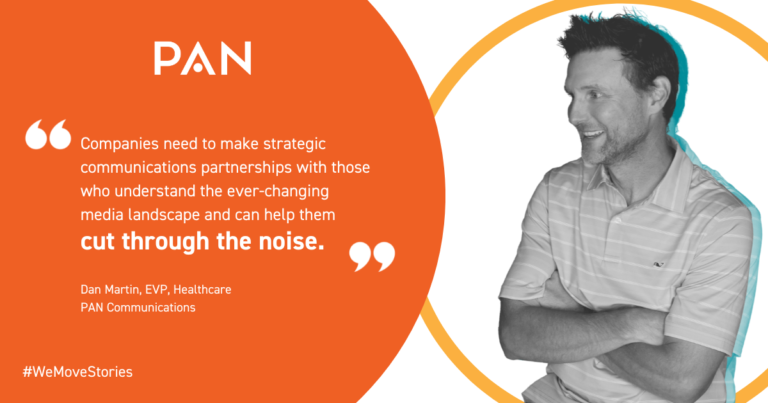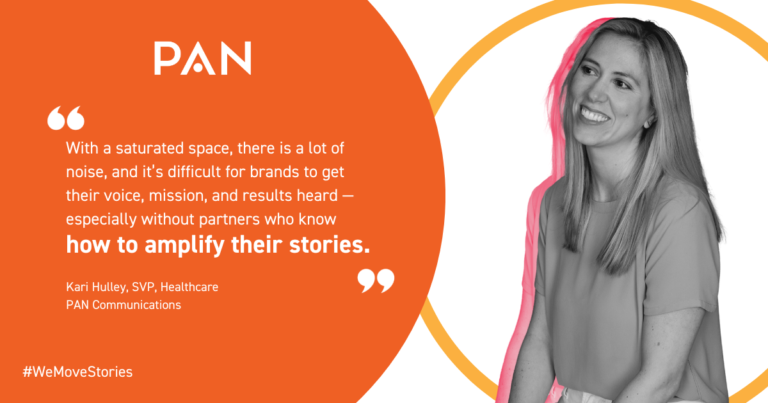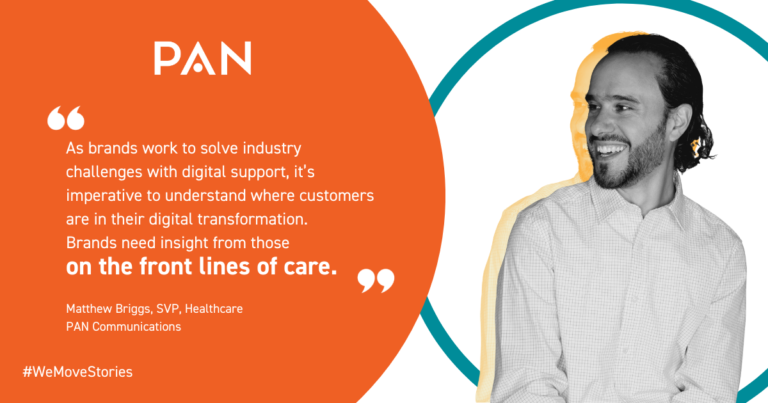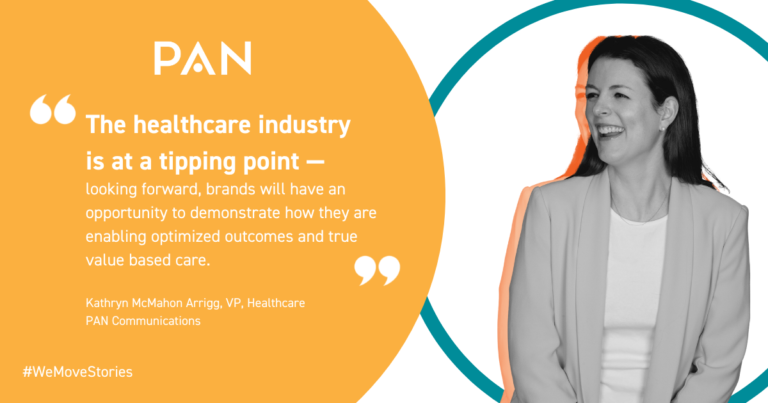How brands and communicators can connect the dots and drive success in a saturated industry
Healthcare is unique in the way it affects everyone — we are all patients. Behind every integrated marketing and public relations firm are people — patients themselves — that are driven by the passion to tell stories of brands trying to fix a fractured system. Although we work in the B2B industry, it’s imperative our stories always have a direct line back to the patient — B2B2C. Highlighting how our clients are breaking down barriers to access, improving quality of care, and reducing healthcare costs in a meaningful way, on the right channels, targeting the appropriate audience, is key. Brands need professionals who know how to connect the dots during a time of technology acceleration and transformation in healthcare. Purpose driven work with patient-centric care at the center is how we meet today and tomorrow’s expectations for clients, their audience, and the patients we ultimately serve.
PAN’s healthcare leadership team — Executive Vice President Dan Martin, Senior Vice Presidents Kari Hulley and Matthew Briggs, and Vice President Kathryn McMahon Arrigg — sat down to share their expert insights on a few critical topics. In the piece below, they discuss how the healthcare industry is changing, the biggest challenge for brands today, what we can expect to see in the next five to 10 years, and how it all impacts the way integrated marketing and public relations works for brands.
How is the healthcare technology industry changing? What is staying the same?
Dan Martin, EV: At the end of the day, when you look at the boom in healthcare and investment over the last ten years, it’s always about the patient and the patient experience. Patients deserve quality healthcare and entities — from providers, to pharma and payers — are using technology to drive patient-centric care, along with controlling costs, and better managing patient populations.
Kari Hulley, SVP: While the healthcare industry is constantly evolving, it’s doing so slowly. The pandemic exposed a number of underlying challenges within healthcare and highlighted what needs to be fixed in the long-term, including cost, lack of diversity, and how healthcare is paid for. Two of the biggest areas of change we’re seeing are stemming from how healthcare is delivered, and how it’s paid for.
Matthew Briggs, SVP: The healthcare industry is shifting to a value-based care (VBC) model, with the focus on quality control and outcomes-based medicine. Along with the change to VBC, we’re seeing the focus on digital innovation and transparency surrounding the need for technology workflows in healthcare to support clinicians. Healthcare leaders and providers are becoming more open and willing to adapt technology to combat industry pain points including the labor shortage and burnout. Patient experience expectations are and will continue to be driving forces in the care continuum.
Kathryn McMahon Arrigg, VP: Every aspect of our lives is digitized — from banking to grocery shopping — and consumers have the same expectations for healthcare. While barriers remain, we are seeing brands across the healthcare continuum leveraging technology in a way that’s bringing us closer to the experience we see in other industries. At the same time, the pandemic has highlighted the immense burnout that clinicians today face. This has raised the question of how technology can help to alleviate that strain in a meaningful and efficient way.
How are those changes and/or stagnation impacting the way IM and PR work for brands?
DM: Healthcare is ripe for innovation and every brand wants to talk about how their technology is changing the industry. Companies need to make strategic communications partnerships with those who understand the ever-changing media landscape and can help them cut through the noise. It’s no longer about simply getting your voice out there, it’s targeting the right audience and stakeholders on relevant channels with compelling messaging.

KH: With every change that occurs regardless of industry — provider, life sciences, payers, etc. — confusion and friction follow. It’s the job of healthcare marketers and public relations specialists to make news digestible and interesting to the client’s audience. It’s vital to take a step back and determine how to tell the best stories possible in a way that mitigates confusion and accurately educates audiences on the greater impact of our clients.
MB: There is a direct correlation between patient expectations and the ability for healthcare companies to clearly articulate their story. Brands must be able to tell their story in a concise and impactful way so the audience can understand the pain points and how the brand is working to change the current landscape. A value-based care story with patients at the center is essential to successful campaigns. However, these campaigns are no longer solely earned media, brands and communicators must create comprehensive strategies across media outlets.
KM: Brands have a responsibility to communicate to stakeholders how technology and digitization is positively impacting the patient (and clinician) experience. That said, it’s necessary to be transparent and realistic about where we are as an ecosystem, and the road ahead. Opportunities lie in a variety of platforms, including corporate blog and multimedia channels, media interviews and on social. It is critical to understand where your audience consumes their information in order to ensure your brand’s story is reaching them in a way that will resonate.
What is the biggest challenge facing healthcare brands today?
DM: Success for brands is not simply building awareness — that’s only step one. True success is being measured also more and more by how strategic communications are helping to secure customers and create revenue in a saturated market. It’s critical to take awareness one step further, ensuring decision makers move down the funnel. Utilizing strategic communications partners, ensuring you’re on the right channels for your audience, and relying on digital tools to increase reach and frequency is paramount.
KH: Healthcare suffers from extreme inertia — and yet, there are new startups every day that are looking to make a life changing impact on patients. With a saturated space, there is a lot of noise, and it’s difficult for brands to get their voice, mission, and results heard — especially without partners who know how to amplify their stories.

MB: Healthcare is a fast-paced environment with big challenges, making it essential for brands to be specific in their messaging. As brands work to solve industry challenges with digital support, it’s imperative to understand where customers and patients are in their digital transformation. To do so, brands need insight on trends and real-world challenges from those on the front lines of care. We’re seeing brands with physician committees or chief medical officers with clinical backgrounds aid in messaging to effectively capture insights to better inform messaging for clients and patients alike.
KM: Every brand in the healthcare space is ultimately trying to better clinical outcomes, improve the patient and physician experience and save costs. Given the crowded nature of the landscape, it can be challenging to differentiate your brand. To stand out from the noise, brands need to clearly and specifically articulate how they are addressing the pain points of the stakeholders whom they are serving. The more simple and straightforward they can be with their message, the better.
What new opportunities do healthcare and HIT brands have, presently or ahead of them?
DM: Investment in digital technologies is no longer a nice to have for health systems and providers — it’s a need to have. Innovation sets organizations apart from competitors by providing a better experience for clinicians and patients alike. Healthcare decision makers are increasingly investing in technology to reduce clinical burnout, and improve the patient experience — all resulting in a higher level of retention and increased return on investment. HC and HIT brands today really need to lean into their true value proposition and tell that story to all key constituents in a compelling way.
KH: The pandemic highlighted unaddressed issues, with spotlights on challenges such as mental healthcare. From a venture capitalist standpoint, there’s a lot of investment to be made. With telehealth continuing to be embraced, there’s a moment for mental health to take center stage across the board and create true impact for patients- and meaningful work for employees and partners. Brands have the opportunity to drive change in areas, such as patient accessibility to care, predictive analysis to eliminate biases in care, and improving diversity in areas such as clinical trials.

MB: Partnering with agencies will always give brands a leg up in understanding how their campaigns are working in market. Understanding open rates and who is engaging and downloading assets can aid in fine tuning and re-targeting authentically, creating the highest ROI and moving customers down the funnel. We’ll also continue to see big companies embracing healthcare for purpose-driven work and from a charitable standpoint. Brands are seeing they can have a greater societal impact aside from their products, and many employees, prospects, and boards are pushing to continue this trend.
KM: There is so much opportunity in today’s landscape for healthcare technology brands to make a significant change. From harnessing healthcare data to improve clinical outcomes, to enabling patients to engage in their healthcare in new ways, there is great promise in what technology can enable. However, to truly see the benefit, brands need to invest in engaging patients in significant and meaningful ways. In order to reach their potential, it is critical for brands to create trust and understanding in not only the upsides of things like telemedicine and population health, but also how patients’ data will be protected throughout the process.
What can brands, consumers and IM/PR professionals expect to see in this industry in the next five to 10 years?
DM: Storytelling will always stay at the center, but the industry will see changes in creative ways and approaches to visualizing and bringing the story to life. We will see the evolution of existing channels, and also brand new channels emerging, helping to target the right audience with concise and compelling messaging.
KH: Integrated marketing and public relations professionals work with niche clients who have a big impact. However, the B2B2C story can get lost if not told the right way. At the core of our job is to balance simplicity with specificity, telling stories accurately and in a way that catches interest quickly. Additionally, the industry will continue to see the lines between earned, owned, and paid media blur, which will shift how brands share content as silos between marketing, public relations, and corporate communications break down.
MB: As the healthcare industry continues to boom, brands and communicators have the opportunity to work together to tell impactful stories about challenges being solved. Determining what it is patients value and how brands are supporting these individuals and communities will drive mission oriented stories. The partnership will be key, as communication professionals can help brands navigate different channels to reach the most appropriate audience with targeted messaging.

KM: The healthcare industry is at a tipping point, and looking forward, brands will have an opportunity to demonstrate how they are enabling optimized outcomes and/or true value based care. With storytelling at the heart of everything that PR and IM professionals do, finding a partner that can help to tell that story in a digestible and relevant way, showcasing results to key stakeholders via appropriate channels will be the key to success.
Learn more about PAN’s healthcare practice.


